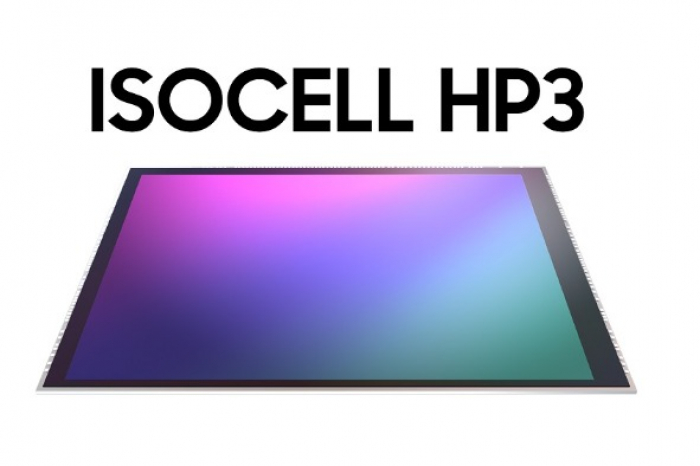
Samsung Electronics unveils new image sensor ISOCELL HP3 on June 23 Samsung Electronics Co. is set to narrow the gap with bigger competitor Sony in the global image sensor market. The South Korean tech giant introduced its 200-million-pixel image sensor ISOCELL HP3 on June 23, which boasts super-high resolution with the industry’s smallest 0.56 micrometer (μm) pixel. An image sensor is a semiconductor that converts light coming through a camera lens into digital data. The quality of the image sensor highly affects a camera's performance. Samsung's new image sensor packs 200 million pixels in a 1/1.4-inch optical format, with a 12% smaller pixel size than the predecessor’s 0.64μm. It allows the sensor to reduce the camera module surface area by up to 20%, enabling smartphone devices to keep slim, Samsung said in a statement. The ISOCELL HP3 also uses a Super Quad Phase Detection (QPD) auto-focusing solution. Additionally, it comes with a single lens over four-adjacent pixels to detect the phase differences to focus an image quickly and accurately. .j-chart {font-family: 'Noto Sans KR', sans-serif; margin-top: 30px;} .j-chart-txt-div {/*margin-left: 5%;*/} .j-chart-h5 {font-size: 21px; font-weight: 600; margin-bottom: 20px; letter-spacing: -0.2px;} .j-chart-h6 {font-size: 15px; font-weight: 400; margin:-5px 0 20px 0} .j-chart-p {display: flex; justify-content: space-between;} .j-chart-p p {font-size: 13px; font-weight: 300; margin-bottom: 0!important; margin-top: 0px;} .j-chart-sub-p {display: flex; margin-left: 6%;} .j-chart-sub-p p {font-size: 14px; font-weight: 400; color: #374140; margin-bottom: 0!important; width: 50%; text-align: center; padding-bottom: 0px;} .d-pc-none {display: none!important} .d-pc-block {display: block!important} .txt-center {text-align: center; margin-top: 50px} .j-chart .year-div-cont {display: flex; justify-content: space-between; flex-wrap: wrap;} .j-chart .year-div {width: 45%;} .j-chart .year {text-align: center; font-weight: 500; font-size: 15px; margin-top: -5px; margin-bottom: 20px;} .j-chart .d-flex {display: flex; justify-content: space-between;} .j-chart .companies-name {font-size: 14px; display: initial;} .j-chart .companies-name span {padding: 10px 10px; margin: 40px 3px 0 10px; border-radius: 100px; display: inline-block; vertical-align: text-bottom;} @media screen and (max-width: 960px) { .j-chart-txt-div {margin-left: 0%;} .j-chart-p {display:block; } .j-chart-p p {margin-top: -6px;} .j-chart-sub-p {margin-left: 10%;} .j-chart-sub-p p {font-size: 13px; padding-bottom: 10px;} .j-chart-h5 {font-size: 22px} .txt-center {text-align: left; margin-top: 20px} .d-pc-none {display: block!important} .d-pc-block {display: none!important} .j-chart .year-div {width: 100%;} .j-chart .year-div {width: 100%;} .j-chart-h6 {font-size: 15px; font-weight: 400; margin:5px 0 10px 0} .j-chart .companies-name {display: initial; font-size: 13px; } .j-chart .companies-name span {padding: 0px 11px; margin: 10px 0px 0 0px; border-radius: 100px; display: grid;} } Global smartphone image sensor market share by vendor in Q1 2022 Unit: % Samsung Electronics Sony OmniVision Others
Source: Strategy Analytics
Graphics by Jerry Lee
var jchartpie = document.getElementById('j-myChart1'); var labels= ['Samsung Electronics (South Korea)', 'Sony (Japan)', 'OmniVision (China)', 'Others'] new Chart(jchartpie, { type: 'doughnut', data: { datasets: [{ data: [28.7, 44.6, 9.5, 17.2], backgroundColor: ["rgba(255, 199, 32, .3)", "rgba(29, 178, 246, .3)", "rgba(244, 86, 74, .3)", "rgba(152, 201, 92, .2)"], borderColor: ["rgba(255, 199, 32, .9)", "rgba(29, 178, 246, .8)", "rgba(244, 86, 74, .7)", "rgba(152, 201, 92, .8)"], borderWidth: 1, }], labels: labels, }, options: { tooltips: { titleFontSize: 14, bodyFontSize: 14, filter: function (tooltipItem, data) { var label = data.labels[tooltipItem.index]; console.log(tooltipItem, data); //console.log(data.datasets) //console.log(datasets) return true } }, responsive: true, legend: { display: false, position: 'top' }, responsiveAnimationDuration: 0, // 크기 변경후 다시뜨는 애니메이션 시간 0초 plugins: { deferred: {enabled: true}, datalabels: { color: '#171717', font: { weight: 'normal', size: 14 }, //anchor: 'end', //clamp: 'true', //align: 'end', padding: 5, borderRadius : 15, //anchor: 'top', formatter: function(value, context) { console.log(context) return value + '%' }, }, } } }) The sensor also enables to take videos in 8K at 30 frames-per-second (fps) or 4K at 120 fps, allowing users to take cinematic videos with smartphones, Samsung stated. It also expresses images in more than 4 trillion colors, or 14-bit color depth, 64 times more colors than the predecessor.Samsung is aiming to increase its share in the global image sensor market with the new product. The Korean tech giant ranks second with 28.7% in the market as of the first quarter of 2022, following Sony’s 44.6%, according to global market research firm Strategy Analytics. Samsung narrowed the gap to 15.9% from 24.5% in the fourth quarter of 2021.Apple Inc. is considering embedding Samsung’s new image sensors in iPhones, according to industry insiders. If Samsung wins supply orders from Apple, the competition between Samsung and Sony will be much fiercer.Samsung became the first company to launch a 200 MP image sensor in September 2021. The product, ISOCELL HP1, had 200 million units of 0.64μm pixels in a 1/1.22-inch optical format. The global image sensor makers are focusing on creating ultra-high resolutions as more smartphone users want high-definition videos and photos, a Samsung official said.By Ji-Eun Jeong jeong@hankyung.com Jihyun Kim edited this article.
Most Read